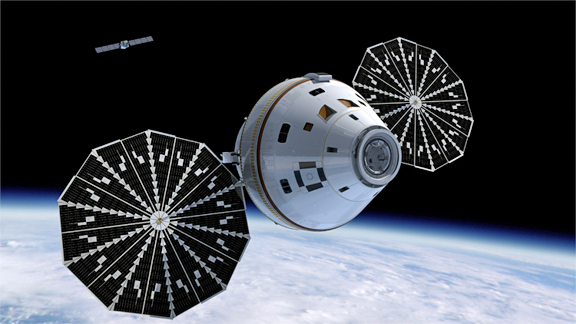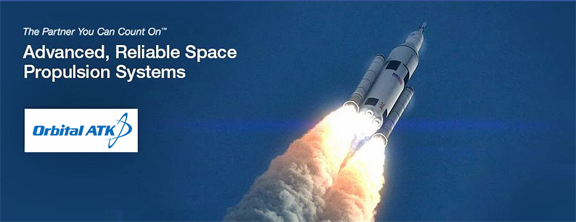[SatNews] Orbital ATK, Inc. (NYSE: OA has signed a $90 million contract with Lockheed Martin to provide the Attitude Control Motor (ACM) for Orion’s Launch Abort System (LAS).
The LAS enables the astronaut crew to safely escape in the event of an emergency during launch, as the capsule is jettisoned away from the launch vehicle. The Orion spacecraft, designed and built for NASA, will transport astronauts to destinations in deep space— and return them safely back to Earth.

Artistic rendition of the Orion spacecraft.
Image courtesy of NASA.
The ACM provides the steering controls to the LAS, using a solid propellant gas generator with eight proportional valves equally spaced around its 3-foot diameter to steer Orion as it moves away from the launch vehicle. The motor can exert up to 7,000 pounds of steering force in any direction.
Cary Ralston, vice president and general manager of Orbital ATK’s Missile Products division of the Defense Systems Group, said, “Orion represents the future of manned spaceflight, and will take humans deeper into space than ever before. Working with Lockheed Martin and NASA, Orbital ATK is committed to making spaceflight safer than ever before for our astronauts.”
“Orbital ATK’s continued support to NASA demonstrates our long-standing commitment to our nation’s human spaceflight program,” said Mike Kahn, president of Orbital ATK’s Defense Systems Group. “This critical work supporting Lockheed Martin on the Orion program recognizes our long history of safety, reliability and innovation.”
To date Orbital ATK has performed several successful ground tests on the ACM, provided a working unit for the successful pad abort test in 2010, and supplied the inert unit which flew as part of Orion’s first test flight, Exploration Flight Test-1 in December 2014. The ACM adds to Orbital ATK's contributions to the LAS, which already includes the primary launch abort motor and the initial system design and engineering.



